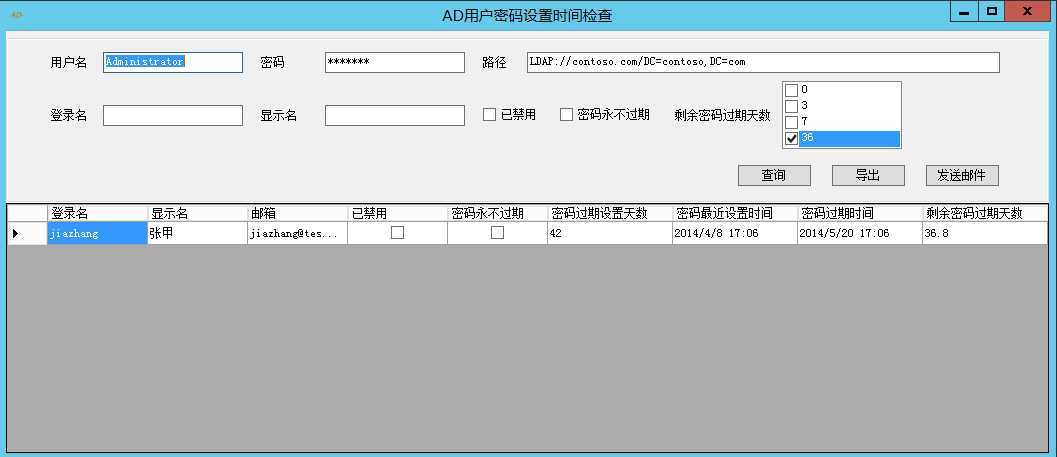标签:blog http 使用 os io 文件 数据 for
本文接着和大家分享AD帐户操作,这次开发一个简单的检查密码将过期用户的小工具。

首先,新建一个用户实体类,属性是我们要取的用户信息。

public class UserInfo
{
/// <summary>
/// sAM帐户名称
/// </summary>
public string SamAccountName { get; set; }
/// <summary>
/// 名称
/// </summary>
public string Name { get; set; }
/// <summary>
/// 邮箱
/// </summary>
public string Mail { get; set; }
/// <summary>
/// 已禁用
/// </summary>
public bool IsDisabled { get; set; }
/// <summary>
/// 设置为密码永不过期
/// </summary>
public bool IsPasswordNeverExpire { get; set; }
/// <summary>
/// 设置为不需要密码
/// </summary>
public bool IsNoPasswordRequired { get; set; }
/// <summary>
/// 系统密码过期设置天数
/// </summary>
public long MaxPasswordAge { get; set; }
/// <summary>
/// 剩余过期天数
/// </summary>
public double? SurplusPasswordExpirationDays {
get
{
if (!PasswordExpirationDate.HasValue)
{
return default(double?);
}
double days = PasswordExpirationDate.Value.Subtract(DateTime.Now).TotalDays;
if (days <= 0)
{
return 0;
}
return Math.Round(days, 2);
}
}
/// <summary>
/// 最近密码修改时间
/// </summary>
public DateTime PasswordLastSet { get; set; }
/// <summary>
/// 密码过期时间
/// </summary>
public DateTime? PasswordExpirationDate { get; set; }
}
然后是搜索用户信息的方法。
private IEnumerable<UserInfo> SearchUsers(string path, string username, string password, string sAMAccountName, string displayName, bool isDisabled, bool IsPasswordNeverExpire, long[] surplusExpirationDays)
{
using (DirectoryEntry directoryEntry = new DirectoryEntry(path, username, password))
{
using (DirectorySearcher directorySearcher = new DirectorySearcher(directoryEntry, @"&(objectCategory=person)(objectClass=user))", new string[] { "name", "sAMAccountName", "userAccountcontrol", "pwdLastSet", "mail" }, SearchScope.Subtree) { PageSize = 1000 })
{
using (SearchResultCollection userResultCollection = directorySearcher.FindAll())
{
foreach (SearchResult userResult in userResultCollection)
{
UserInfo userInfo = new UserInfo();
//TODO: 赋值
yield return userInfo;
}
}
}
}
}
这次我们主要用DirectorySearcher类:SearchRoot是搜索的DirectoryEntry根节点;SearchScope属性是搜索的范围,是个SearchScope枚举:Base(限于基对象)、OneLevel(搜索基对象的直接子对象,但不搜索基对象)、Subtree(搜索整个子树,包括基对象及其所有子对象)。我们要在指定的OU下搜索用户,所以选择子树Subtree。
DirectorySearcher类的Filter属性是过滤条件,搜索用户就是“&(objectCategory=person)(objectClass=user))"。注意:表示与或非的“&”、“|”、“!”要放在这些条件表达式前面而不是它们之间;如果要做模糊查询用通配符*;可以用“=”、“>=”、“<=”、“~=”(约等于),但“>”和”<“是不行的;”pwdLastSet“要转为Windows文件时间,因为存的是个long,还有处理”userAccountControl"的并运算,这里用“:1.2.840.113556.1.4.803:=”。我们可以把一些查询条件放在Filter里,减少搜索结果的返回行数:
directorySearcher.SearchScope = SearchScope.Subtree;
List<string> filterItems = new List<string>();
if (!string.IsNullOrEmpty(sAMAccountName))
{
filterItems.Add(string.Format(@"(sAMAccountName={0})", sAMAccountName));
}
if (!string.IsNullOrEmpty(displayName))
{
filterItems.Add(string.Format(@"(name={0})", displayName));
}
if (!containsDisabled)
{
filterItems.Add(@"(!(userAccountControl:1.2.840.113556.1.4.803:=2))");
}
if (!containsPasswordNeverExpire)
{
filterItems.Add(@"(!(userAccountControl:1.2.840.113556.1.4.803:=65536))");
}
if (!containsNoPasswordRequired)
{
filterItems.Add(@"(!(userAccountControl:1.2.840.113556.1.4.803:=32))");
}
if (surplusExpirationDays != null && surplusExpirationDays.Length > 0)
{
StringBuilder surplusExpirationDaysFilter = new StringBuilder(@"(|");
DateTime now = DateTime.Now;
foreach (long surplusExpirationDay in surplusExpirationDays)
{
DateTime passwordExpirationDate = now.AddDays(surplusExpirationDay);
DateTime passwordLastSet = passwordExpirationDate.AddDays(-1 * maxPwdAge);
if (surplusExpirationDay != 0)
{
surplusExpirationDaysFilter.AppendFormat("(&(pwdLastSet>={0})(pwdLastSet<={1}))", passwordLastSet.ToFileTime().ToString(), passwordLastSet.AddDays(1).AddSeconds(-1).ToFileTime().ToString());
}
else
{
surplusExpirationDaysFilter.AppendFormat("(pwdLastSet<={0})(pwdLastSet=0)", passwordLastSet.AddDays(1).AddSeconds(-1).ToFileTime().ToString());
} }
surplusExpirationDaysFilter.Append(@")");
filterItems.Add(surplusExpirationDaysFilter.ToString());
}
directorySearcher.Filter = string.Format(@"(&{0}(objectCategory=person)(objectClass=user))", string.Concat(filterItems));
Filter语法请参考:http://msdn.microsoft.com/en-us/library/aa746475.aspx、http://www.ldapexplorer.com/en/manual/109010000-ldap-filter-syntax.htm。
userAccountControl标志请参考:http://support.microsoft.com/kb/305144/zh-cn、http://msdn.microsoft.com/zh-cn/library/ms680832(VS.85).aspx、http://technet.microsoft.com/library/ee198831.aspx。
DirectorySearcher类的PropertiesToLoad属性是要检索的属性列表,这个就相当于我们访问数据库时写SQL语句里SELECT后面的东西,最好按需指定,尽量不写“SELECT *”; 注意DirectorySearcher类的PageSize属性,如果要返回所有数据可以设为1000,默认是只返回1000条的。
directorySearcher.PropertiesToLoad.AddRange(new string[] { "name", "sAMAccountName", "userAccountcontrol", "pwdLastSet", "mail" });
directorySearcher.PageSize = 1000;
更多DirectorySearcher类属性请参考:http://msdn.microsoft.com/zh-cn/library/System.DirectoryServices.DirectorySearcher_properties(v=vs.80).aspx
用户密码的过期日期可以通过DirectoryEntry对象的InvokeGet方法获得,不过要加载一次DirectoryEntry的话,总觉得很浪费!
using (DirectoryEntry resultDirectoryEntry = userResult.GetDirectoryEntry())
{
userInfo.PasswordExpirationDate = DateTime.Parse(resultDirectoryEntry.InvokeGet("PasswordExpirationDate").ToString());
}
所以我还是愿意自己算一下,用最近密码设置时间+系统设置的密码过期天数。最近密码设置时间对应“pwdLastSet”,如果用DirectoryEntry对象的Properties取,那是个“System.__ComObject”类型值,幸好SearchResult对象的“pwdLastSet”可以直接取为long,这个值是Windows文件时间,可以再转为本地时间。
long fileTime = (userResult.Properties["pwdLastSet"][0] as long?).GetValueOrDefault(); userInfo.PasswordLastSet = DateTime.FromFileTime(fileTime);
系统密码过期天数是通过组策略设置的,可以在OU路径下通过“maxPwdAge”属性获取,SearchResult对象的“maxPwdAge”也可以直接取为long。
directorySearcher.SearchScope = SearchScope.Base;
directorySearcher.Filter = @"(objectClass=*)";
directorySearcher.PropertiesToLoad.Add("maxPwdAge");
SearchResult ouResult = directorySearcher.FindOne();
long maxPwdAge = 0;
if (ouResult.Properties.Contains("maxPwdAge"))
{
maxPwdAge = TimeSpan.FromTicks((long)ouResult.Properties["maxPwdAge"][0]).Days * -1;
}
最后,用户的密码过期就可以这么求了!
userInfo.MaxPasswordAge = maxPwdAge;
if (!userInfo.IsPasswordNeverExpire)
{
userInfo.PasswordExpirationDate = userInfo.PasswordLastSet.AddDays(userInfo.MaxPasswordAge);
}
查询用户信息OK,剩下贴段将用户信息导出Excel的代码:
 View Code
View Code还有使用SmtpClient发送邮件的代码,可以自定义个HTML文件做模版内容:
 View Code
View Code
最后,将这些代码整合起来,就是检查用户密码过期的小工具了!由于笔者水平有限,文中难免会有些疏漏和错误,代码也有待不断优化,欢迎各位高手提出宝贵的建议!
参考资料:
DirectoryEntry 类使用 http://msdn.microsoft.com/zh-cn/library/z9cddzaa(v=vs.110).aspx
DirectorySearcher 类使用 http://msdn.microsoft.com/zh-cn/library/System.DirectoryServices.DirectorySearcher(v=vs.90).aspx
轻量目录访问协议 (LDAP) http://msdn.microsoft.com/en-us/library/aa367008(VS.85).aspx
检查密码将过期用户小工具下载地址:http://files.cnblogs.com/CSharpDevelopers/UserPasswordSetChecker.zip
AD帐户操作C#示例代码(二)——检查密码将过期的用户,布布扣,bubuko.com
标签:blog http 使用 os io 文件 数据 for
原文地址:http://www.cnblogs.com/lschenblog/p/3897988.html